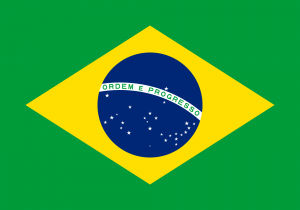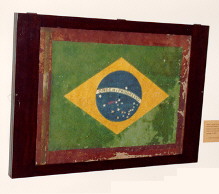 Official name: Federal Republic of Brazil República Federativa do Brasil (in Portuguese) Capital: Brasilia Location: South America Date of adoption: May 11, 1992 by Law 8421 (originally adopted by Decree 4 in November 19, 1889). Its presentation and use are regulated by Law 5700 of September 1, 1971. Proportion: 7:10 |
Designed by Raimundo Teixeira Mendes, president of the Positivist Apostolate of Brazil, with the collaboration of Miguel Lemos and Manuel Pereira Reis, astronomy professor at the Polytechnic School. The design was executed by the painter Decio Vilares.
It was inspired by the Empire Flag, designed by the French painter Jean-Baptiste Debret.
Design
Maintained the tradition of the old national colors – green and yellow – as follows: a yellow diamond on a green field, with the blue and starry celestial sphere in the middle, crossed by a white band obliquely and downward from left to right, with the words “Ordem e Progresso (Order and Progress)” in green.
The stars in the Brazilian flag should be considered as seen by an observer located outside the celestial sphere.
Meaning
On September 7th, 1822, after demanding “Independence or Death”, the Prince Regent Dom Pedro (later Emperor Dom Pedro I) removed the blue and white Portuguese headdress from his hat and said, “From now on we use another tie, green and yellow. These shall be the national colors. “On September 18th, Dom Pedro signed three decrees which were the first acts of the independent Brazil. The second decree created a new national headdress: “The Brazilian bow-knot (tie), or headdress (tope) will consist of the emblematic colors: spring green and yellow gold …”

Brazilians celebrate with flags the 3-1 victory over Ivory Coast in the World Cup 2010.
Throughout the existence of the Brazilian flag, different interpretations were made regarding the meaning or representativity of its colors. There is a popular reading that relates the colors of the flag with natural aspects of the territory of the country, such as the relation of the green in the flag with the abundance of the Amazon forest, or yellow with the richness of the earth.
The fact is that the colors have their meanings depending on who is giving, however, we highlight other aspects, as discussed below:
The green and yellow colors are related to the royal house of Braganza, which Dom Pedro I was part, and the royal house of Habsburg, which Empress Dona Leopoldina was part. The blue circle refers to the image of a celestial sphere, positioned as the latitude of the city of Rio de Janeiro at 12 sidereal hours (08 hours and 30 minutes) of November 15th, 1889 – local and day of the Proclamation of the Republic.
The stars represent each state of the federation. They show five different magnitudes and the differentiation of sizes is related to astronomical aspects directly or indirectly. The stars that are part of the sphere, are part of nine constellations. One is the Southern Cross which can be seen from all Brazilian states and was set at the center of what represents the sky in the flag.
Click to view details about the constellations of the flag and the correspondence between the stars and the states.
The inscription “Ordem e Progresso (Order and Progress)” is attributed to the French philosopher Auguste Comte, who had many followers in Brazil, including Professor Teixeira Mendes, who conceived the basic design of the flag.
Curiosities
• Each of the stars corresponds to a Brazilian state and they must be updated in case of creation or termination of any state. The single star above the inscription “Ordem e Progresso (Order and Progress)” is called Spica and represents the state of Pará that in the year 1889 corresponded to the largest Brazilian territory above the Equator line.
 • Original drawing of Brazil’s flag is stolen from church in Rio. Folha de São Paulo newspaper: “The original drawing of the flag of Brazil, made by the painter Decio Vilares in 1889, was stolen from the Positivist Church of Brazil in the southern zone of Rio, on April 27. There are no suspects to the crime. According to Giovane Fernandes, the church caretaker, the thief broke into a side door. After taking the screws from behind the protective structure, removed the painting, which was under a stand, without breaking the glass frame. “ |
References:

